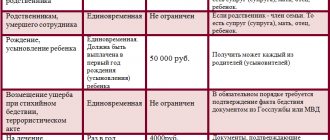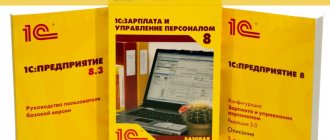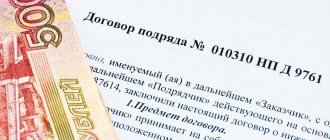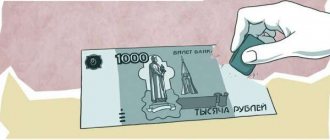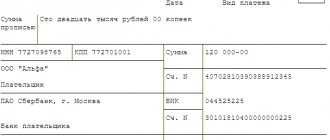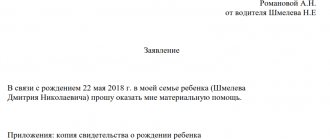Tax agent
The amount of material benefit is subject to personal income tax (Article 210, subparagraph 1, paragraph 1, Article 212 of the Tax Code of the Russian Federation).
In relation to material benefits received by an employee, the organization (lender) acts as a tax agent. Therefore, she must calculate personal income tax from the amount of material benefit and transfer the tax to the budget. This is stated in paragraph 4 of paragraph 2 of Article 212 of the Tax Code of the Russian Federation.
Situation: who should transfer personal income tax to the budget from material benefits - the head office of the organization or a separate division? The employee received an interest-free loan at the head office of the organization, but he works in a separate division.
The personal income tax amount must be transferred by the head office of the organization at the location of the separate division.
In this case, it does not matter where the employee received the loan: at the head office or at his place of work in a separate division. For calculating personal income tax, the only thing that matters is that the loan was received in the same organization in which the employee works (clause 3 of article 55 of the Civil Code of the Russian Federation, clause 1 of article 226 of the Tax Code of the Russian Federation).
As a general rule, all payments in favor of employees of a separate division are withheld and transferred to the personal income tax budget by the head office of the organization at the location of the separate division. This is stated in paragraph 7 of Article 226 of the Tax Code of the Russian Federation.
The head office may assign the responsibility for withholding and transferring personal income tax to the budget to a separate unit. For information on the conditions that must be met, see How a tax agent can pay personal income tax to the budget.
Insurance premiums from the cost of food for employees
If an organization partially compensates the costs of its employees for food, whether or not to pay insurance premiums depends on how it is drawn up in the documents.
Meals for employees: what about insurance premiums?
The company feeds employees on its own initiative. Should insurance premiums be calculated?
Date of receipt of income
Material benefit must be calculated on the date of receipt of income. This date will be the last day of each month during the period for which the employee received the loan. Therefore, determine the amount of material benefit monthly, regardless of the date:
- payment of interest;
- obtaining and repaying a loan.
For example, on January 31, 2021, on February 29, 2021, etc. Even if the contract was concluded before 2021.
This is stated in subparagraph 7 of paragraph 1 of Article 223 of the Tax Code of the Russian Federation and explained by the Ministry of Finance of Russia in letter dated March 18, 2016 No. 03-04-07/15279 (brought to the attention of tax inspectorates by letter of the Federal Tax Service of Russia dated March 29, 2021 No. BS -4-11/5338).
You can withhold tax from your next salary. The amount of withholding cannot exceed 50 percent of the payment. This follows from paragraph 4 of Article 226 of the Tax Code of the Russian Federation.
Situation: at what point should one determine the material benefit from saving on interest on an interest-free loan. The loan was issued to an employee in 2015, will it be repaid in 2021?
Determine material benefits on the last day of each month starting January 31, 2021.
In this situation, it is necessary to apply new rules that are in force from January 1, 2021. That is, income in the form of material benefits from interest-free loans is determined on the last day of each month. For the first time, this needs to be done only starting in January 2021, when the new procedure has already come into force.
During 2015, the person did not have any income in the form of material benefits. Because according to the old rules, until 2021, income in the form of financial benefits was calculated on the date of loan repayment. Since the interest-free loan was issued in 2015, and its repayment period is in 2021, then the first date for receiving income will be January 31, 2021. This decision was given by specialists from the Russian Ministry of Finance.
The material benefit that you determine for the first time in the transition period is calculated from the date the loan was issued until January 31, 2021. In the future, until the loan repayment date, determine the income for each month on its last day (February 29, March 31, etc.).
This procedure follows from subparagraph 7 of paragraph 1 of Article 223 of the Tax Code of the Russian Federation. It is also confirmed by representatives of the Russian Ministry of Finance in private explanations.
An example of how to determine the material benefit of an interest-free loan. The loan was issued in 2015 with a maturity date in 2016
On October 1, 2015, Alpha LLC issued an interest-free loan to an employee in the amount of 600,000 rubles. The loan repayment period is March 31, 2016.
As of January 31, 2021, the accountant calculated personal income tax on material benefits for the period from October 1, 2015 to January 31, 2021.
The number of days in 2015 is 365, in 2021 – 366.
The refinancing rate (conditionally) from January 1, 2021 is 11 percent.
January 31, 2021:
Number of days of using the loan to calculate interest: – from October 2, 2015 to December 31, 2015 – 91 days; – from January 1 to January 31, 2021 – 31 days.
The amount of material benefits as of January 31 was: 600,000 rubles. × 2/3 × 11% : 365 days. × 91 days + 600,000 rub. × 2/3 × 11%: 366 days. × 31 days = 14,697 rub.
Personal income tax on material benefits for January: RUB 14,697. × 35% = 5144 rub.
In the future, the accountant calculates personal income tax at the end of each month of using the loan.
February 29, 2021:
The amount of material benefits as of February 29 was: 600,000 rubles. × 2/3 × 11%: 366 days. × 29 days = 3486 rub.
Personal income tax on material benefits for February: 3,486 rubles. × 35% = 1220 rub.
March 31, 2021:
The amount of material benefits as of March 31 was: 600,000 rubles. × 2/3 × 11%: 366 days. × 31 days = 3727 rub.
Personal income tax for material benefits for March: 3,727 rubles. × 35% = 1304 rub.
Calculation of material benefits
When calculating the monthly financial benefits for loans provided to employees, use the following formulas.
If a loan in rubles is issued with interest, but the interest rate is lower than 2/3 of the refinancing rate, apply the formula:
| Material benefit from a loan issued in rubles at interest | = | 2/3 | × | Refinancing rate on the date of receipt of income | – | Interest rate under the agreement | × | Loan amount | : | 365 (366) days | × | Number of calendar days in a month or days of loan provision in a calendar month |
If a loan in foreign currency is issued with interest, but the interest rate under the loan agreement is below 9 percent per annum, calculate the material benefit using the formula:
| Material benefit from a loan issued in foreign currency at interest | = | 9% | – | Interest rate under the agreement | × | Loan amount | : | 365 (366) days | × | Number of calendar days in a month or days of loan provision in a calendar month |
Calculate the material benefit from an interest-free loan issued in rubles using the formula:
| Material benefit from an interest-free loan issued in rubles | = | 2/3 | × | Refinancing rate on the date of receipt of income | × | Loan amount | : | 365 (366) days | × | Number of calendar days in a month or days of loan provision in a calendar month |
If an interest-free loan is issued in foreign currency, calculate the material benefit as follows:
| Material benefit from an interest-free loan issued in foreign currency | = | 9% | × | Loan amount | : | 365 (366) days | × | Number of calendar days in a month or days of loan provision in a calendar month |
If the loan was repaid in parts within a month, calculate the material benefit as follows:
| Material benefit from a loan issued in rubles at interest with partial repayment | = | 2/3 | × | Refinancing rate on the date of receipt of income | – | Interest rate under the agreement | × | Loan amount before partial repayment | : | 365 (366) days | × | Number of calendar days of loan provision in a calendar month until the day of partial repayment (inclusive) | + | ||||||||
| + | 2/3 | × | Refinancing rate on the date of receipt of income | – | Interest rate under the agreement | × | Loan amount after partial repayment | : | 365 (366) days | × | The number of calendar days of loan provision in a calendar month from the day following the day of partial repayment to the day of the next partial (full) repayment or to the last day of the month |
Follow the same procedure for partial repayment of a loan in foreign currency and an interest-free loan.
This procedure follows from the provisions of paragraph 2 of Article 212 of the Tax Code of the Russian Federation.
Situation: what refinancing rate should be used when calculating the material benefit (for personal income tax purposes) received by an employee from using an interest-bearing loan? Interest paid in arrears.
When calculating the material benefit, use the refinancing rate set on the last day of each month of using the loan.
And even if the employee is late in paying interest, he will have taxable income on this date. This procedure follows from subparagraph 7 of paragraph 1 of Article 223 of the Tax Code of the Russian Federation.
An example of determining the material benefit of a loan provided to an employee. Interest is calculated monthly based on 1/2 the refinancing rate
On May 28, Alpha LLC issued a loan in the amount of 1,800,000 rubles to one of its employees. at 1/2 the refinancing rate (conditionally). Under the agreement, interest is accrued monthly and repaid at the end of the agreement. The loan is not related to the purchase of housing. The employee must repay the debt on January 11 of the following year.
The number of days in 2021 is 366.
Refinancing rates (conditionally): – from May 28 to July 31 – 8 percent; – from August 1 to November 30 – 10 percent; – from December 1 to January 31 – 12 percent.
The accountant calculates personal income tax at the end of each month of using the loan.
May
The amount of interest accrued based on the refinancing rate in effect on the last day of May was: RUB 1,800,000. × 2/3 × 8%: 366 days. × 3 days = 787 rub.
Amount of interest accrued based on the actual rate under the agreement: RUB 1,800,000. × 1/2 × 8%: 366 days. × 3 days = 590 rub.
Material benefit: 787 rub. – 590 rub. = 197 rub.
Personal income tax on material benefits for May: 197 rubles. × 35% = 69 rub.
August
The amount of interest accrued based on the refinancing rate in effect on the last day of August was: RUB 1,800,000. × 2/3 × 10% : 366 days. × 31 days = 10,164 rub.
Amount of interest accrued based on the actual rate under the agreement: RUB 1,800,000. × 1/2 × 10%: 366 days. × 31 days = 7623 rub.
Material benefit: RUB 10,164. – 7623 rub. = 2541 rub.
Personal income tax for material benefits for August: 2541 rubles. × 35% = 889 rub.
December
The amount of interest accrued based on the refinancing rate in effect on the last day of December was: RUB 1,800,000. × 2/3 × 12%: 366 days. × 31 days = 12,197 rub.
Amount of interest accrued based on the actual rate under the agreement: RUB 1,800,000. × 1/2 × 12% : 366 days. × 31 days = 9148 rub.
Material benefit: RUB 12,197. – 9148 rub. = 3049 rub.
Personal income tax on material benefits for December: 3049 rubles. × 35% = 1067 rub.
January
The amount of interest accrued based on the refinancing rate in effect on the last day of January was: RUB 1,800,000. × 2/3 × 12% : 365 days. × 11 days = 4340 rub.
Amount of interest accrued based on the actual rate under the agreement: RUB 1,800,000. × 1/2 × 12% : 365 days. × 11 days = 3255 rub.
Material benefit: 4340 rub. – 3255 rub. = 1085 rub.
Personal income tax on material benefits for January: 1085 rubles. × 35% = 380 rub.
Gifts, loans, accounts and insurance premiums
When transferring gifts to an employee under a gift agreement, the organization does not incur insurance premiums. Courts often exempt the value of gifts from contributions on another basis.
Gifts for employees: should there be insurance premiums?
Taxes and contributions for forgiveness of debt to an employee
Accountable money without documents is subject to insurance premiums
Are additional compensation for early dismissal subject to contributions and personal income tax?
Personal income tax rate
Personal income tax must be withheld from material benefits at a rate of 35 percent (clause 2 of Article 224 of the Tax Code of the Russian Federation). If the loan is issued to a non-resident, then the personal income tax rate is 30 percent (clause 3 of article 224 of the Tax Code of the Russian Federation). This rate applies even if the material benefit accrues to a non-resident who is a highly qualified specialist. This is explained by the fact that the income of non-residents - highly qualified specialists received from their work activities (paragraph 4, paragraph 3, article 224 of the Tax Code of the Russian Federation) is taxed at a rate of 13 percent.
Loan issued for the purchase of housing
Withhold personal income tax on material benefits for loans issued to residents for the purchase (construction) of housing or land in a special manner.
If borrowing costs are not included in the property tax deduction that an employee receives when purchasing (constructing) housing or land, the material benefit is subject to personal income tax for residents at a rate of 35, and for non-residents at a rate of 30 percent. If an employee who is a resident has the right to receive a property tax deduction related to the purchase (purchase) of housing (land), the material benefit is not recognized as income subject to personal income tax. Even if at the time of the material benefit the property tax deduction has already been spent (or has not yet been used). Since a prerequisite for exemption from personal income tax is the citizen’s right to a deduction in relation to housing (land), for the construction or acquisition of which a loan was allocated.
This procedure follows from the provisions of subparagraph 1 of paragraph 1 of Article 212 and paragraph 2 of Article 224 of the Tax Code of the Russian Federation, as well as letter of the Ministry of Finance of Russia dated September 4, 2009 No. 03-04-05-01/671.
A loan provided to an employee to repay a mortgage loan for the purchase of housing is not a targeted loan. If an organization issues such a loan to an employee, the latter receives a material benefit from savings on interest, subject to personal income tax at a rate of 35 or 30 percent (letter of the Ministry of Finance of Russia dated October 7, 2009 No. 03-04-05-01/727).
Situation: how to calculate personal income tax on material benefits for an interest-free loan issued for the purchase of housing (land)? The loan amount exceeds the maximum amount of property deduction (RUB 2 million).
The amount of material benefit from an interest-free loan issued to an employee for the purchase (construction) of housing or land is not subject to personal income tax. This rule applies only to those employees who are entitled to receive a property tax deduction. Moreover, even if the loan amount exceeds the maximum amount of property tax deduction (2 million rubles), income in the form of material benefits is not subject to personal income tax in full. The legislation does not provide for such a condition for the exemption of material benefits from personal income tax as the maximum amount of property deduction. This follows from the provisions of subparagraph 1 of paragraph 1 of Article 212 and subparagraph 3 of paragraph 1 of Article 220 of the Tax Code of the Russian Federation.
Calculate the material benefit from an interest-free loan in the manner prescribed by paragraph 2 of Article 212 of the Tax Code of the Russian Federation.
A similar point of view is expressed in letters of the Ministry of Finance of Russia dated April 14, 2008 No. 03-04-06-01/85 and dated January 25, 2008 No. 03-04-06-01/20.
Payments from net profit may still not be subject to insurance premiums.
Previously, before 2010, many taxpayers used the provisions of paragraph 3 of Article 236 of the Tax Code of the Russian Federation, according to which the unified tax was not levied on payments that were not recognized as tax expenses. However, with the abolition of the tax and the introduction of insurance premiums, this opportunity, as many experts said, was lost - there is no similar provision in the Federal Law of July 24, 2009 No. 212-FZ.
According to officials, this means that any payments and rewards in favor of employees are subject to insurance premiums, regardless of whether they are taken into account when taxing profits or not.
It would seem that in this way the legislator deprived taxpayers of the choice between reducing the base for insurance premiums or the base for income tax. But this is not so - the norms of the legislation on insurance premiums even now allow them not to be calculated from payments to employees from net profit. It's all about the literal understanding of the provisions of Law No. 212-FZ.
The key factor is whether the payment to the employee is mentioned in the employment contract
The object of taxation of insurance premiums is defined in Part 1 of Article 7 of Law No. 212-FZ.
verbatim “The object of taxation of insurance premiums <…> are payments and other remunerations accrued <…> in favor of individuals under employment contracts and civil contracts, the subject of which is the performance of work, provision of services (with the exception of <…>) , as well as under author’s order agreements, agreements on the alienation of the exclusive right to works of science, literature, art, publishing license agreements, license agreements on granting the right to use works of science, literature, art” Part 1 of Article 7 of the Federal Law of July 24, 2009 No. 212 -FZ.
If we do not touch upon exotic payments, for example, under copyright and licensing agreements, then in relations with employees, insurance premiums should be accrued only for payments under labor or civil law contracts. If this rule is interpreted literally, it turns out that remuneration not provided for in such agreements is not subject to insurance premiums.
In practice, payments to employees from net profit were never specified in employment contracts. After all, officials have repeatedly explained that labor costs recognized in tax accounting can include only those payments that are mentioned in collective or labor agreements (clause 2, 25 of Article 255 of the Tax Code of the Russian Federation). If the amount is provided for by another local act, then employment contracts must contain a reference to it. All other remunerations are recognized as paid out of net profit (letters of the Ministry of Finance of Russia dated 02/05/08 No. 03-03-06/1/81, dated 03/19/07 No. 03-03-06/1/158, Federal Tax Service of Russia for Moscow dated 05.04 .05 No. 20-12/22796). Therefore, if an organization intended to pay amounts from net profit and not be subject to unified social tax, it tried to avoid mentioning them in labor or collective agreements. Such payments were established by other local acts of the company without any reference to them.
Thus, taxpayers who complied with these explanations from officials may still not be subject to insurance premiums on payments from net profit, as they were not subject to UST before. Although claims are almost guaranteed here.
Why is it profitable to pay from net profit without charging contributions?
Payments from net profit, not subject to insurance premiums, are more profitable from the point of view of the overall tax burden, if the annual remuneration of one employee does not exceed 415 thousand rubles (clause 4 of article 8 of law No. 212-FZ). The point is a higher rate of insurance premiums compared to the income tax rate (see table below). The effective savings will be about 0.8% (RUB 2,400 : RUB 300,000 × 100%). However, from 2011, the difference in the tax burden between these options will already be 7.2% (21,600 rubles / 300,000 rubles × 100%).
If payments per employee exceed the mentioned limit, after which insurance premiums are not charged, then payments that reduce taxable profit become most profitable.
The Ministry of Social Health Development interprets the law in its own way
Officials clearly do not agree with this interpretation. They believe that any employee benefits should be subject to insurance premiums. Thus, the letter of the Ministry of Health and Social Development of Russia dated March 23, 2010 No. 647-19 states the following. According to Part 1 of Article 7 of Law No. 212-FZ, “the object of taxation with insurance premiums includes all payments in favor of employees made within the framework of labor relations, with the exception of those directly exempted.” Including amounts provided for in labor contracts, collective agreements, agreements, and local regulations of the employer.
Although the controversial norm does not contain anything of the kind, the Ministry of Social Health Development concludes that payments to employees that are not directly stated in employment contracts, but are nevertheless made within the framework of the legal relationship between employees and the employer, are subject to insurance contributions.
This opinion will most likely have to be challenged in court. Due to the recent introduction of insurance premiums, practice on this issue has not yet developed.
The rule on other payments does not apply here either.
Representatives of local funds can give another argument in favor of charging insurance premiums. According to Part 1 of Article 7 of Law No. 212-FZ, the object of their taxation may also be payments and other remunerations accrued in favor of individuals subject to compulsory social insurance in accordance with federal laws on specific types of compulsory social insurance. This rule is often interpreted in the spirit that even if an employee is paid any amounts not on the basis of an employment or civil law contract, they are still subject to insurance premiums.
However, the officials of the Ministry of Health and Social Development of Russia themselves explained that it applies only to those employees who can perform a labor function in an organization and receive wages without concluding employment or civil contracts with them (letter dated 02.11.10 No. 286-19). For example, deputies, other civil servants or members of production cooperatives. Therefore, it is unlawful to apply this argument to payments from net profit to ordinary employees.
What documents can provide for payments?
The credibility of the employer company’s position depends entirely on the execution of documents regarding the disputed payment.
Draw up a gift agreement.
The Russian Ministry of Health and Social Development itself confirms this option. Thus, in letters dated 03/05/10 No. 473-19 and dated 02/27/10 No. 40619, officials indicated that gifts to employees that are transferred to employees under a separate gift agreement are not subject to insurance contributions. They emphasize that a gift agreement is a civil contract, the subject of which is the transfer of ownership of property. And payments under such agreements are directly exempt from insurance premiums (Part 3, Article 7 of Law No. 212-FZ). Moreover, the officials themselves say that nothing prevents the company from donating cash.
From the mentioned letter from the Ministry of Health and Social Development of Russia, we can indirectly conclude that if the gift is formalized in a separate gift agreement, but at the same time it is provided for by the employment contract, then insurance premiums will also not arise. This is beneficial in relation to income tax, since the cost of such gifts can be included in tax expenses (letter of the Ministry of Finance dated 04/22/10 No. 03-03-06/2/79). But the risk of claims in this case increases significantly.
Make payments before concluding or after terminating an employment contract.
If we rely on the position of officials, then in order to exempt the payment from insurance premiums, it is necessary to prove that it was not, in principle, related to labor relations.
In our opinion, this is possible if payments to the employee were made before concluding or after terminating an employment contract with him. For example, lifts, which are designed to help a new employee arrange their daily life. Or severance pay paid after termination of an employment contract.
The fact that such payments are not related to labor functions was confirmed by the Russian Ministry of Finance when considering the question of whether they can be recognized as a tax expense. Officials considered that if at the time of payment of money the employee was not in an employment relationship with the company, then such remuneration is not related to wages (letter dated July 23, 2009 No. 03-03-05/138).
Issue as a separate order.
Also not related to the employee’s performance of his labor function is the financial assistance paid to him according to the order of the manager from net profit. Of course, if it is not provided for in the employment contract. In practice, annual financial assistance for vacation in an amount that often exceeds the employee’s salary is very common.
Here officials have an additional argument. They can point out that paragraph 11 of part 1 of Article 9 of Law No. 212-FZ directly states that financial assistance in the amount of only 4 thousand rubles is not subject to insurance contributions. It follows from this that all amounts exceeding the limit are included in the base.
However, only those payments that were included in the base can be exempt from taxation. If financial assistance is not mentioned in the employment contract, it is, in principle, not subject to taxation. Regardless of your size. This will probably have to be proven in court. Even the regional administration is unlikely to agree with this interpretation.
Also, in our opinion, various types of bonuses that are not tied to labor results and not mentioned in the employment contract are not related to the employee’s job responsibilities. For example, a bonus for years of service, for an anniversary, for victories in various corporate and departmental competitions, etc.
Provide for it in the collective agreement and take it into account in tax expenses (the riskiest way).
From the literal interpretation of Article 7 of Law No. 212-FZ, it follows that payments provided exclusively by a collective agreement are not included in the object of taxation by insurance premiums. This can also be used. The main thing is that these provisions are not indicated in the employment contract with the employee.
This is the most profitable and riskiest option, since it makes it possible to avoid contributions and recognize payments in tax accounting. The fact is that paragraphs 5 and 25 of Article 255 of the Tax Code of the Russian Federation make it possible to take into account remuneration in favor of employees provided for in labor or collective agreements. And only the first of them are subject to insurance premiums.
When refusing to recognize costs only under a collective agreement, officials, of course, can refer to paragraph 21 of Article 270 of the Tax Code of the Russian Federation. According to this rule, payments other than employment contracts do not reduce taxable profit. But there are court decisions in favor of the fact that mention of payment in a collective agreement, together with other company documents, is sufficient to recognize the amount as a tax expense (resolution of the Federal Arbitration Court of the North-Western District dated January 29, 2008 No. A05-12892/2006, upheld by the ruling Supreme Arbitration Court of the Russian Federation dated 03.06.08 No. 6669/08).
Pay income to a group of people.
To calculate insurance premiums, it is necessary to determine the income of a specific employee - the basis for calculating contributions. However, if this cannot be done, then there is no need to pay fees. At least, regarding the unified social tax, the courts took exactly this position (for example, the resolution of the Federal Arbitration Court of the Far Eastern District dated 06.15.09 No. F03-2484/2009 and paragraph 8 of the information letter of the Presidium of the Supreme Arbitration Court of the Russian Federation dated 06.21.99 No. 42).
For example, it is almost impossible to determine the income of a specific employee if the company, in accordance with the terms of the collective agreement, pays employees for food, travel, sports, etc. That is, it pays income in kind to a group of people - calculate the share of expenses falling on each person impossible. Personal income tax for employees also does not arise for this reason. In addition, the company will be able to take these expenses into account for ensuring normal working conditions for income tax purposes.
Tax officials may claim that the company did not specifically keep records of the consumption of these benefits by employees in order to save on contributions and personal income tax. They say that all this is physically possible to do with the help of various statements, coupons, etc. Here everything will depend on the convincingness of the company’s argument.
Comparison of payment processing options, thousand rubles.
| Index | Payments are included in expenses and are subject to contributions | Payments are not recognized as expenses and are subject to contributions | Payments from net profit without calculating contributions |
| Payments in the amount of 300 thousand rubles per year (2010) | |||
| Insurance premiums | 78 (300 thousand rubles × 26%) | 78 (300 thousand rubles × 26%) | – |
| Reduction of taxable profit | 378 (300 + 78) | 78 (letter of the Ministry of Finance of Russia dated October 19, 2009 No. 03-03-06/2/197) | – |
| Income tax savings | 75.6 (378 thousand rubles × 20%) | 15.6 (78 thousand rubles × 20%) | – |
| General expenses | 302,4 (300 + 78 – 75,6) | 362,4 (300 + 78 – 15,6) | 300 |
| Change in costs compared to last option | Increase by 2.4 (302.4 – 300) | Increase by 62.4 (362.4 – 300) | 0 |
| Payments in the amount of 600 thousand rubles per year (2010) | |||
| Insurance premiums | 107.9 (415 thousand rubles × 26%) | 107.9 (415 thousand rubles × 26%) | – |
| Reduction of taxable profit | 707,9 (600 + 107,9) | 107,9 | – |
| Income tax savings | 141.58 (707.9 thousand rubles × × 20%) | 21.58 (107.9 thousand rubles × × 20%) | – |
| General expenses | 566,32 (600 + 107,9 – 141,58) | 686,32 (600 + 107,9 – 21,58) | 600 |
| Change in costs compared to last option | Decrease by 33.68 (566.32 – 600) | Increase by 86.32 (686.32 – 600) | 0 |
| Payments in the amount of 300 thousand rubles per year (2011) | |||
| Insurance premiums | 102 (300 thousand rubles × 34%) | 102 (300 thousand rubles × 34%) | – |
| Reduction of taxable profit | 402 (300 + 102) | 102 | – |
| Income tax savings | 80.4 (402 thousand rubles × 20%) | 20.4 (102 thousand rubles × 20%) | – |
| General expenses | 321,6 (300 + 102 – 80,4) | 381,6 (300 + 102 – 20,4) | 300 |
| Change in costs compared to last option | Increase by 21.6 (321.6 – 300) | Increase by 81.6 (381.6 – 300) | 0 |
| Payments in the amount of 600 thousand rubles per year (2011) | |||
| Insurance premiums | 141.1 (415 thousand rubles × 34%) | 141.1 (415 thousand rubles × 34%) | – |
| Reduction of taxable profit | 741,1 (600 + 141,1) | 141,1 | – |
| Income tax savings | 148.22 (741.1 thousand rubles × 20%) | 28.22 (141.1 thousand rubles × 20%) | – |
| General expenses | 592,88 (600 + 141,1 – 148,22) | 712,88 (600 + 141,1 – 28,22) | 600 |
| Change in costs compared to last option | Decrease by 7.12 (592.88 – 600) | Increase by 112.88 (712.88 – 600) | 0 |
Property deduction for housing
An employee can confirm the right to exemption from personal income tax for material benefits received from savings on interest for the use of borrowed funds with the following documents from the tax office:
- notification, the form of which was approved by order of the Federal Tax Service of Russia dated January 14, 2015 No. ММВ-7-11/3;
- a certificate, the form of which is recommended by the letter of the Federal Tax Service of Russia dated July 27, 2009 No. ШС-22-3/594.
To receive a notification (certificate), the employee must contact the tax office at his place of residence with a set of supporting documents required when receiving a property deduction (documents confirming ownership of housing or acquisition of rights to housing under construction, as well as payment of expenses for the purchase (construction) of housing, land plot). It is enough for the employee to receive a supporting document (notification, certificate) and submit it to the organization once. If an organization has issued a long-term loan and the material benefit from interest savings occurs in different tax periods, then there is no need to annually require the employee to provide a new supporting document from the tax office.
This follows from the provisions of subparagraph 1 of paragraph 1 of Article 212, paragraph 3 of Article 220 of the Tax Code of the Russian Federation and clarifications of the Ministry of Finance of Russia in letters dated September 17, 2010 No. 03-04-05/6-559, dated September 14, 2010 No. 03- 04-06/6-211.
Work situations when accountants doubt
Daily allowance is paid to an employee to reimburse additional expenses associated with a business trip. The Labor Code of the Russian Federation does not establish a maximum daily allowance. This value is determined in the company’s local regulations.
Daily allowance for a business traveler: what about insurance premiums?
Business trip + vacation: what about personal income tax and insurance premiums?


